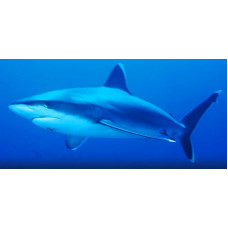Latin name
Carcharhinus albimarginatus
Other names
Carcharhinus albimarginatus
Identification
It is a powerful fish with a streamlined body, a moderately long and wide snout, and large round eyes. It has five pairs of short gill slits.
Teeth
There are 12-14 rows of teeth on each side of each jaw, plus one or two small teeth in the symphysis. The upper teeth are triangular, with a bevelled tip and coarse serrations at the base; the lower teeth are more symmetrical, with fine serrations and more concave edges.
The teeth on the upper and lower jaws have different shapes, which allows them to hunt large prey, using sharp serrations to grab and tear off pieces of flesh.
Features of fish fins
The first dorsal fin is large and triangular. There is a ridge between the first and second dorsal fins. The pectoral fins are proportionally longer than those of most sharks in the genus and are sickle-shaped with pointed ends.
Fish colouring
The dorsal colouration is grey-blue with a bronze tinge, the belly is white. All fins are bordered by a thin white stripe.
Distribution
Widespread but uneven distribution in the tropical Indian and Pacific Oceans. In the western Indian Ocean, this species is found from the Red Sea to South Africa, including Madagascar, the Seychelles, the Aldabra archipelago, Mauritius and the Chagos Archipelago. In the western Pacific, this shark is found from southern Japan to northern Australia, including Madagascar, the Seychelles, the Aldabra archipelago, Mauritius and the Chagos Archipelago. Taiwan, Philippines, Indonesia, New Caledonia, Guam, Palau, Solomon Islands, Marshall Islands, Phoenix Islands and Tahiti. In the eastern Pacific it is found from southern California to Colombia, including the Cocos, Galapagos and Revilla Hijedo Islands. Its presence in the Gulf of Mexico and the Caribbean has not been confirmed.
Habitat
Benthopelagic species. They inhabit continental and island shelves at depths of 30-800 m. They are most commonly found around isolated islands, coral shoals and reef cliffs. Juveniles inhabit coastal shoals or lagoons, while adults prefer deep water and almost never mix with juveniles.
Size
Sharks grow up to 3m in length, but the average length is 2.0-2.5m. The highest recorded weight is 162.2kg. Females are larger than males.
Behavior
Although these sharks are very mobile, they do show attachment to specific locations and there is evidence of territorial behaviour. They are usually found alone or in pairs. Small groups of adult females have been observed at depth. Individuals are very aggressive towards each other, with many showing signs of severe injury. There is evidence that they dominate Carcharhinus galapagensis and Carcharhinus limbatus of equal size in competition for food. Silvertips sometimes form interspecific groups with Carcharhinus amblyrhynchos. Sometimes they follow Tursiops sp. In open water they are accompanied by Naucrates ductor.
Food and feeding habits
Sharks feed mainly on bony fish such as epinephelus, scombridae, tuna, escolar, flying fish, wrasse and flatfish. Eagle rays, small sharks and octopus are sometimes their prey.
Larger sharks become slow and feed mainly on bottom dwellers. These fish have been observed swimming around groups of feeding sharks of other species, sometimes breaking in to take food from them.
Reproduction
Like sharks of the genus Carcharhinus, they are viviparous: after the embryo has exhausted its yolk supply, the empty yolk sac becomes a placenta, through which the mother feeds the embryo. In the southern hemisphere, mating and birth take place in summer. During courtship, the male bites the female to hold her down during mating; one female observed had the tip of her first dorsal fin bitten off. The female gives birth to between 1 and 11 pups (usually 5 or 6) every two years, with gestation lasting about 1 year. The size of the newborns is 63-68 cm or 73-81 cm (data from different authors) and the acolytes live in shallower waters than the adults. Growth rates vary widely in the wild. Males and females become sexually mature when they reach 1.6-2 m in length.
Fishing
Fished for commercial gain. Occasionally caught in shark and tuna longline and gillnet fisheries.
Relationship with a person
Potentially dangerous to humans. When pursued by divers, these sharks will display a threatening behaviour to warn of an imminent attack. This involves the shark swimming rapidly away from the pursuer for about 15 metres and then turning in the opposite direction. At a distance of two hulls, the shark will stop, lower its pectoral fins, open its mouth, curl up the back 2/3 of its body and "shudder". The last two elements are unique to the species, the "trembling" may serve to accentuate the white edge of the fins. If the diver continues to pursue, the shark may quickly approach and inflict a wound with its upper teeth.
This species often approaches vessels because it is attracted to certain low frequency artificial sounds.
Human consumption.
| Classification | |
| Phylum | Chordata |
| Class | Chondrichthyes |
| Squad | Carcharhiniformes |
| Family | Carcharhinidae |
| Genus | Carcharhinus |
| Species | C. albimarginatus |
| Features | |
| Conservation status | Vulnerable |
| Habitat | Bottom |
| Life span, years | No information |
| Maximum body weight, kg | 162,2 |
| Maximum length, cm | 300 |
| Sailing speed, m/s | No information |
| Threat to people | Edible |
| Way of eating | Predator |
Silvertip shark
Tags: silvertip shark



